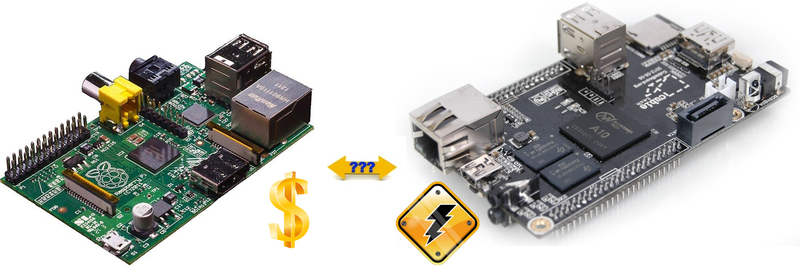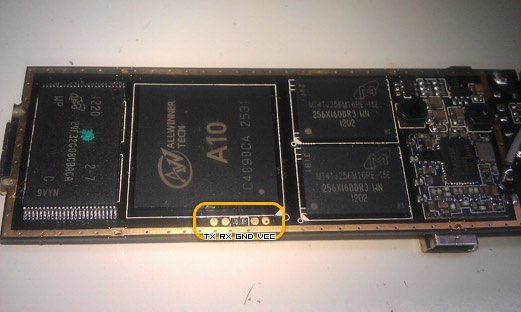CubieBoard is expensive, Raspberry Pi is weak, or where to get SoC with GPIO is more powerful and cheaper

Raspberry Pi became a national single-payer almost immediately after its appearance, since there were no cheaper, smaller, and more universal SoC systems. However, now the time has come when the Chinese are releasing cheap, and compact SoCs like the AllWinner A10 with a frequency of up to 1.2 GHz, which look noticeably more attractive than the 0.7 GHz raspberry pie.
Of course there is CubieBoard, which has everything that the developer might need on itself, and a processor more powerful than the RPi, although single-core, but the Cortex A8 is 1.2 GHz, and it has Gig and SATA ports, and in general, probably, he beats RPi in everything, except for the lack of analog video, but he has one drawback. If an RPi officially costs $ 35, although you can buy an official RPi from a dealer in Russia to whom you send an official website for only 2500 r. then he even has a Chinese copy on ebay for $ 40, while CubieBoard is officially from China, but its price on ebay is $ 83, and having 2 less powerful RPi is already more attractive to me than one powerful CubieBoard, and even 100 rubles for
However, there is a Chinese hero who is ready to lie on a sharp picket fence of contention between a powerful processor and low cost. However, it is completely unsuitable for most projects for which the above machines are imprisoned. He was also recognized as popular, in terms of price and power, but in a different class of devices, in the class of silent home media servers, his name is MK802. More than once described on Habré, and on the Internet, the Android miniPC MK802 with the ability to boot Linux from a microSD card puts it on a par with the processor power with CubieBoard and, accordingly, higher than the Raspberry Pi, but it has the main drawback - no GPIO . This almost puts an end to the possibility of using it as a powerful processor, say for the brains of a robot, or a smart home system.
But it does have a USB Host, and not one, so why not see the USB-GPIO adapters? However, the result is not very encouraging. Basically, such devices are the prerogative of FTDI, which produces wonderful devices and modules, for example, such would be ideal:

However, there is a catch, price. For example, here it stands as the MK802 itself, could not be found cheaper.
But. Why is Durin not a GPIO? After all, the cost of Arduino Nano on ebay is only 350 p.
Of course, evil tongues will say, but why then in general MK802? Well, I’m silent about the processor, indeed, for most Atmega328 projects it’s enough for the eyes, but let's take at least two of the first conspicuous features, WiFi and USB host. To connect them to Arduino you need two modules that cost 550 rubles for the cheapest USB host and 1800 rubles for the same WiFi shield, all together it will cost about 2800 rubles and look something like this:

Well, in all respects Cubieboard is not a competitor. Whereas the MK802 + Arduino nano is 1500r, and the following parameters:

Among other things, and in terms of size, the MK802 outperforms competitors, this can be an important factor for an aircraft model who wants to put a webcam on his quadrocopter and control it via WiFi.The Arduino does not significantly increase the thickness of the device compared to the RJ-45 connector on the RPI and CubieBoard. But Arduino occupies a USB port, more precisely miniUSB port because on MK802 one of the USB host ports is made in such a form factor, it is probably more appropriate to use it. Something like this for example.


Although it’s more logical to unsolder both miniUSB connectors, and after drilling a couple of holes in the case, connect them with 4 short wires.
And here the main question pops up, for which a topic was created. Arduino Nano has an ATMega 328 processor with a body kit (quartz, passive elements, LEDs ...) and an FDTI USB-UART converter chip. But here's the question, why do we need to use USB twice? On the MK802 board, not all Allwinner crystal pins are output (for example, there is no Line-in audio, which is unfortunate), but the UART is displayed in the form of 4 round copper pads next to the SoC to which only the lazy one does not solder.

A console for debugging dead devices has been hung on this UART. But you can also get to the console from the axis (if your device is of course loading) And on the Internet there are descriptions of how you can connect an IRDA receiver to these pins instead of the console. Is it possible to get it to flash ATMega328? Well, for example, already with the Arduino bootloader. At the very least, let's take this device called Arduino mini:

What is just a diluted percent with the Arduino bootloader and quartz. It costs 150r (as usual on ebay). The pins of interest to us, by the way, are displayed on the left (in the picture) edge of the board.
So here. The process of uploading a sketch from a computer to an arduino is a special package. Arduino UART command input during its loading, with subsequent transfer of the compiled sketch to the same UART. The logical question is how to make the Arduino IDE for Linux accept UART as a COM port, and how can you restart the arduino programmatically? Let's say some LED, or some other indication pin to use as a GPIO for the reset pulse. Or is it all not too real? Question to experienced Linux and ARM
After all, if this is feasible, then we get for a maximum of 1300 r, i.e. at the price of a Chinese copy of the Raspberry Pi, the machine is smaller, with a more powerful processor, memory, built-in WiFi and more, 2 free USB, 22 GPIO, and since ATMega328 (and maybe Arduino mini) fits inside the MK802 case, then a single-module device.
Hang a cheap webcam on it, soldering a miniUSB connector to its shortened cable, on the GPIO subpropellers, flaps, wheels, propeller, fins, cranes, solenoids, or an electric mop drive, and you have a home or field robot, helicopter, boat, self-propelled gun, vacuum cleaner, color watering device, manipulator, security system or anything with a server, configurable from work, business trip, and from anywhere via the Internet and Wi-Fi. For 1300 rub. but with the power of a non-top laptop, the power consumption of charging from the iphone, and the quietness of the rock garden. I put it on a helicopter, stuck 3G modem in a free USB port, and flew over the summer house to fly, and it distributes the caught Internet via WiFi, you have fun, your wife checks the mail (this is of course a joke, but in the style of Because we can).
About infrared hereand generally a lot of useful things.
Pictures, except for self-drawn from google search on tags “MK802, Arduino” and from FTDI
UPD website.
Approximate prices are taken from Ebay.com, just in case I’ll indicate where exactly, but I apologize in advance if the listings expire, as happened with the copy of RPi for $ 40 which I don’t find now, but instead appeared for $ 35. In general, the indicated prices are valid at the time of writing, delivery is calculated to Russia.
Raspbery Pi Here is a copy for 1100r (promised to copyright holders $ 35) Here for 1300r .
CubieBoard Here is the cheapest kit with delivery that we managed to find 2600r .
But later in the comments neepolas suggested that herethe device itself for the stock costs $ 50, and delivery costs $ 10, respectively, now the cheapest Cubieboard costs 1800r , not twice, but still more expensive than RPI and MK802.
MK802 1GB RAM for 1300R .
